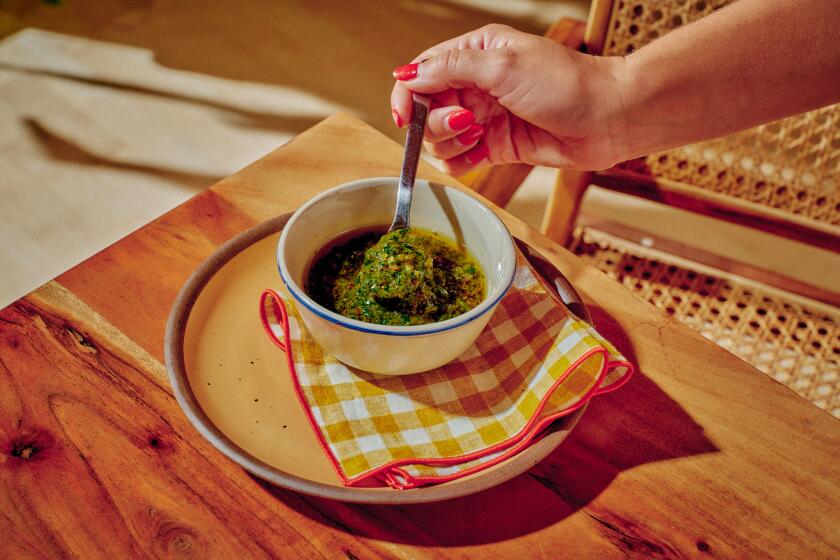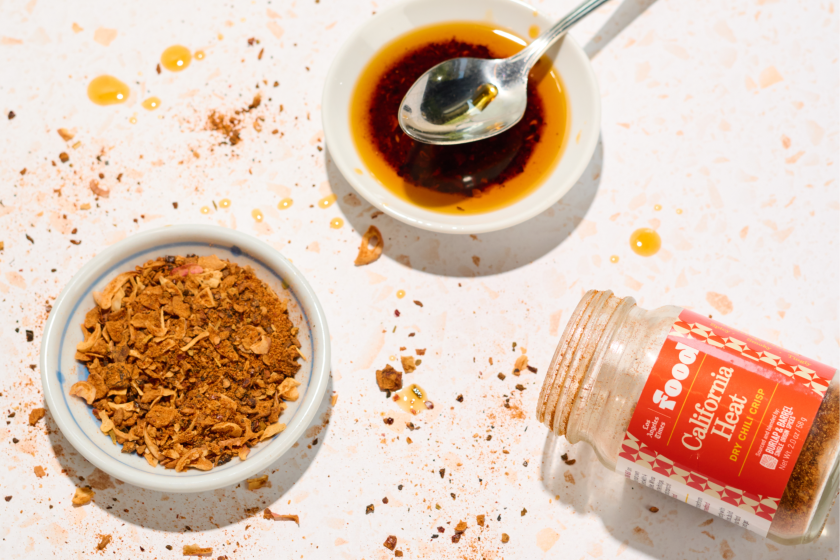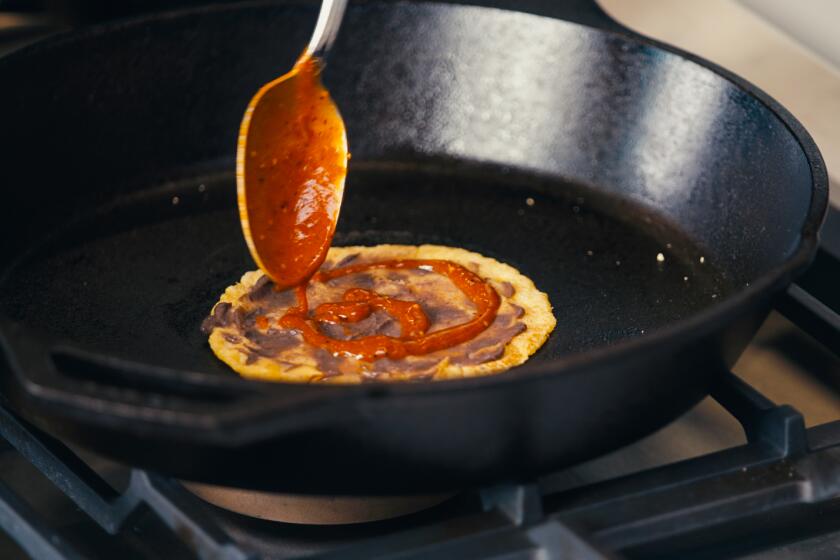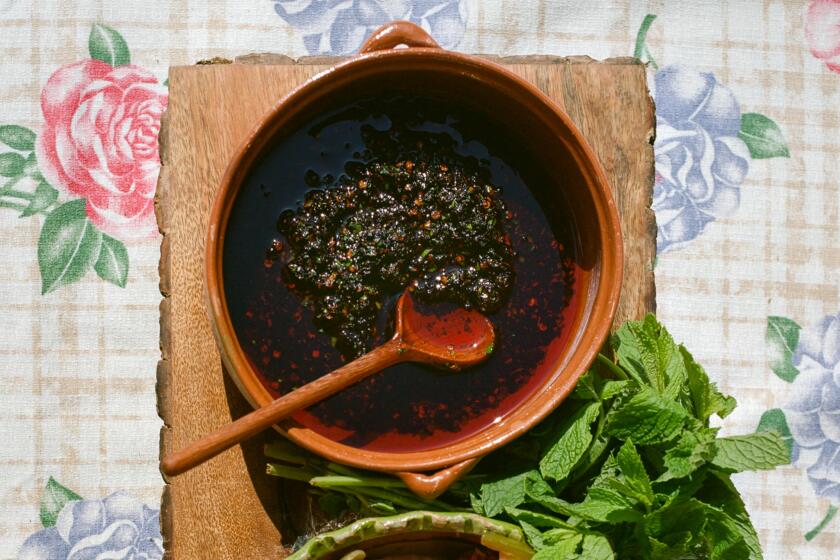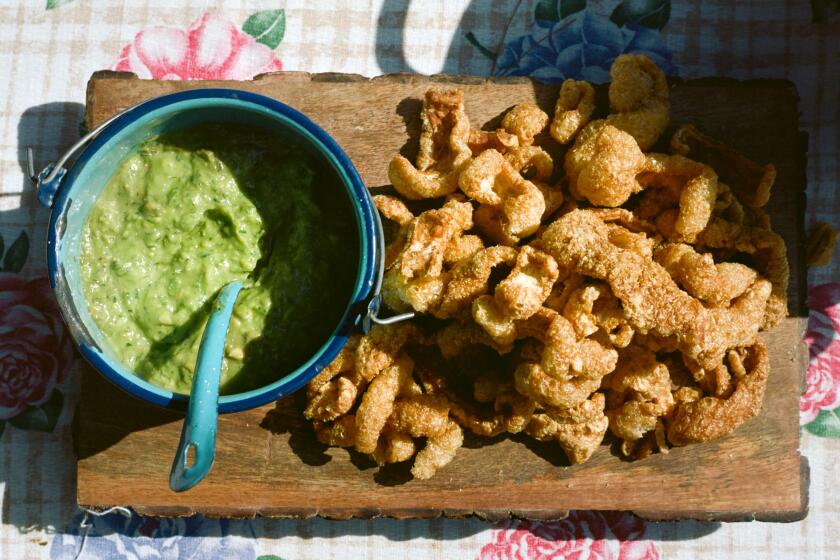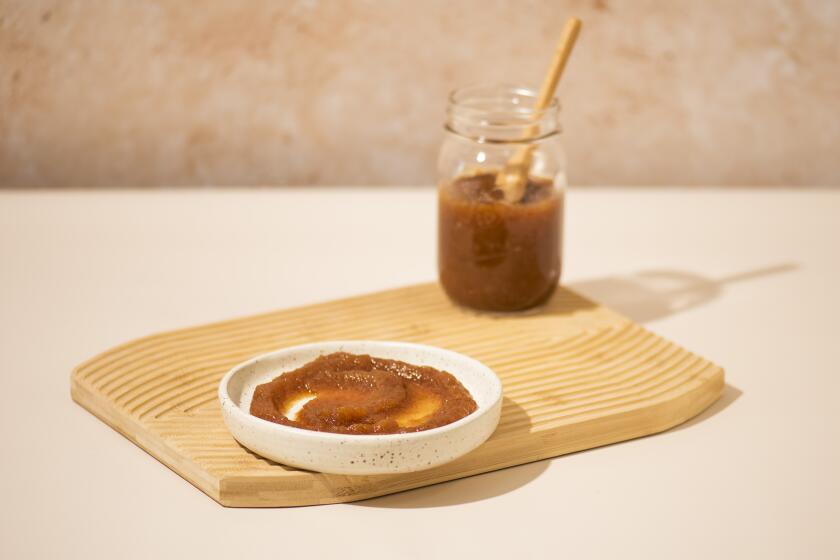Wilted parsley
- Share via
Convenience foods have a horrible reputation, in most cases entirely justified. In the quest for ease, other attributes -- such as flavor -- get tossed willy-nilly by the wayside.
But there is an exception. In fact, let’s go even further: One of the world’s most inconvenient foods also comes in a convenient easy-to-cook package. Soft-shell crabs: what a great invention.
Soft-shell crabs are blue crabs (genus: Callinectes: “beautiful swimmer”; species: sapidus: “delicious”) that have been captured in mid-molt. Blue crabs (the toast of the East and Gulf coasts, which nature has tragically deprived of our vastly superior Dungeness) are sweet enough, it is true. But when it takes five minutes of determined cracking through sharp bits of shell to get at a paltry couple of ounces of meat, you really begin to recalculate the cost-benefit ratio.
Once a year, though, blue crabs give us a break. Freed from that poorly designed packaging, they deliver all of the sweet crab flavor with none of the fuss. But wait, it gets better. Once a regional specialty or restaurant splurge, they are now available at fancy groceries in Southern California. Imagine, soft-shell crabs whenever you want them.
Well, it’s not quite that simple. In the first place, soft-shells are seasonal: They’re here only in the late spring and early summer. And then there’s the price. Even when you cook them yourself, they are still expensive -- almost $6 a piece.
Don’t let that put you off, though. There are few things that are easier to fix and there are almost none that are better. Roll a crab in a little flour and fry it quickly. Do it just right and you get an irresistible combination of crunchy crust and sweet, buttery, briny crabmeat. Serve it with a nice tart salad and a simple sauce and you’ve got a meal you’ll remember for years.
That soft-shell crabs cost so much is no mystery. In fact, it’s just short of a miracle that we get them at all. Harvesting soft-shell crabs is as much craft as catch.
To grow, crabs need to shed their hard shells. Essentially, they get so big they simply burst out of them (a feeling with which many soft-shell crab eaters probably have some sympathy). When the crabs are young, they grow rapidly and may do this as often as every several days. When they get bigger, eating size, it can take several months.
Watermen who catch crabs have learned to recognize signs that tell them how soon this will happen. The next-to-the-last small swimming leg is the key: when a trace of white appears, the crab will molt within a couple of weeks. When it turns pink, it’s a matter of days. When the leg shows red, they’re just about ready to bust.
Just-caught crabs are sorted accordingly and stored in saltwater cages. There they are inspected three or four times a day in order to be harvested at just the right moment -- when they have shed their old shells and before the new soft skin has had a chance to harden (something it will begin to do within a matter of hours if left alone).
That’s when we get them, flown in and, ideally, still alive but stored on ice so their metabolism has slowed enough that they may appear otherwise.
The trickiest part about cooking soft-shells is cleaning them, and that’s not so much hard as horrific. It’s definitely not for the squeamish. The first step is cutting off the crab’s “face” about a quarter-inch behind its eyes. This kills the crab, though it may still twitch a bit. Remove the gray sand sac inside. Lift the tips of the shell and cut out the gills, or “dead man’s fingers.” Cut off the apron underneath and the crab is ready for cooking.
At most seafood markets (at least the ones fancy enough to sell soft-shells), the counterman will clean them for you. This is fine as long as you’re planning on cooking the crabs within a couple of hours.
When you’re shopping for soft-shells, try to get the biggest, plumpest ones you can. Most places air-freight the crabs in several times a week, but if you’re not picky, sometimes you’ll still get crabs that are limp and drained.
There really is only one best way to cook soft-shell crabs -- frying (there are recipes for broiling, but these are to be tried only after you’ve had your absolute fill of fried). Even within the narrow realm of frying, there are many choices to be made.
The simplest way to prepare crabs for frying is merely to dip them lightly in flour. This gives you a very light, slightly crisp crust. Other cooks use cornmeal or a mixture of flour and cornmeal. Some use bread crumbs or even crushed saltines.
All of these may be fine for everyday eating, but when I get soft-shells only once or twice a season, I want something with more bang for my buck. My ideal of a soft-shell crab is more like the seafood version of chicken Kiev: a very crisp crust that practically explodes with juice when you cut into it.
To get this crust, you need to use some egg. But pure egg makes the crust too heavy and too thick to coat evenly. Beating in a bit of milk is the key. It lightens the batter and thins it so it will cover every nook and cranny of the crab. The lactose sugars in the milk also make the crust a nicer brown than you would get if you used egg by itself.
The process of flour-egg wash-flour is a bit messy, but it can be done well in advance. In fact, refrigerating the battered crabs for even half an hour before frying sets the crust so it won’t fall apart during cooking. You can prepare them as much as a couple of hours ahead if you’d like.
I find it easiest to batter the crabs and chill them on a wax paper-covered cookie sheet while I prepare the sauce and the side dishes. That way, the entire meal is ready when it is time to fry.
Although you can deep-fry soft-shells, I think just a quarter to half an inch of oil in a heavy skillet is sufficient. Just make sure the oil is hot before you start. This much oil isn’t deep enough to allow the accurate use of a thermometer, so fall back on the old bread test: Dip the corner of a piece of bread in the oil; when it sends up a thick rush of bubbles, the oil is hot enough. (Be sure to remove the crust, which hardly bubbles at all.)
The frying should be fast and furious. Keep the fire at medium-high and the surface of the oil boiling. The crabs will take only four or five minutes for each side to brown, time enough for them to be cooked through.
From Louisiana to Maryland, it seems that the classic accompaniment to a fried soft-shell crab is tartar sauce. Don’t snicker. A good homemade tartar sauce is to the commercial version what a home-grilled hamburger is to the drive-up window kind.
And it couldn’t be simpler to make: Spike a good quality commercial mayonnaise with minced green onions and cornichons and a dab of mustard and there you are.
Forget convenience food, this is a convenience feast.
Russ Parsons can be reached at [email protected]
Cut the stems from the parsley, then gather all of the tops together in a big bunch and cut in quarters. Place the tops in a large bowl filled with water and swirl them around to wash thoroughly.
Heat the garlic and the oil together in a large skillet over medium heat. Let the garlic color to a deep brown but don’t let it scorch. Grab a big handful of parsley from the bowl of water and, without squeezing it dry, place it in the skillet. It will pop fiercely, so stand back. When that parsley has turned a deep green, add the remaining parsley, draining it but not squeezing it dry. Cook, tossing and stirring, until the parsley begins to wilt, about 5 minutes.
When the parsley is slightly wilted but not limp, squeeze the lemon juice over top and season to taste with salt. This can be held over very low heat for 10 minutes until ready to serve.
Get our Cooking newsletter.
Your roundup of inspiring recipes and kitchen tricks.
You may occasionally receive promotional content from the Los Angeles Times.











